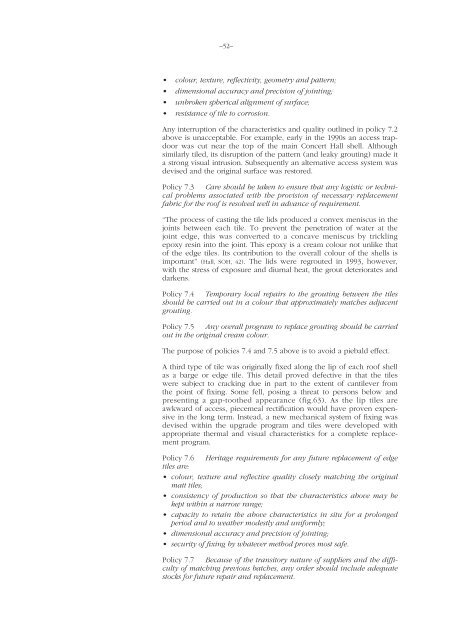Sydney Opera House conservation plan
Sydney Opera House conservation plan
Sydney Opera House conservation plan
You also want an ePaper? Increase the reach of your titles
YUMPU automatically turns print PDFs into web optimized ePapers that Google loves.
–52–• colour, texture, reflectivity, geometry and pattern;• dimensional accuracy and precision of jointing;• unbroken spherical alignment of surface;• resistance of tile to corrosion.Any interruption of the characteristics and quality outlined in policy 7.2above is unacceptable. For example, early in the 1990s an access trapdoorwas cut near the top of the main Concert Hall shell. Althoughsimilarly tiled, its disruption of the pattern (and leaky grouting) made ita strong visual intrusion. Subsequently an alternative access system wasdevised and the original surface was restored.Policy 7.3 Care should be taken to ensure that any logistic or technicalproblems associated with the provision of necessary replacementfabric for the roof is resolved well in advance of requirement.“The process of casting the tile lids produced a convex meniscus in thejoints between each tile. To prevent the penetration of water at thejoint edge, this was converted to a concave meniscus by tricklingepoxy resin into the joint. This epoxy is a cream colour not unlike thatof the edge tiles. Its contribution to the overall colour of the shells isimportant” (Hall, SOH, 42). The lids were regrouted in 1993, however,with the stress of exposure and diurnal heat, the grout deteriorates anddarkens.Policy 7.4 Temporary local repairs to the grouting between the tilesshould be carried out in a colour that approximately matches adjacentgrouting.Policy 7.5 Any overall program to replace grouting should be carriedout in the original cream colour.The purpose of policies 7.4 and 7.5 above is to avoid a piebald effect.A third type of tile was originally fixed along the lip of each roof shellas a barge or edge tile. This detail proved defective in that the tileswere subject to cracking due in part to the extent of cantilever fromthe point of fixing. Some fell, posing a threat to persons below andpresenting a gap-toothed appearance (fig.63). As the lip tiles areawkward of access, piecemeal rectification would have proven expensivein the long term. Instead, a new mechanical system of fixing wasdevised within the upgrade program and tiles were developed withappropriate thermal and visual characteristics for a complete replacementprogram.Policy 7.6 Heritage requirements for any future replacement of edgetiles are:• colour, texture and reflective quality closely matching the originalmatt tiles;• consistency of production so that the characteristics above may bekept within a narrow range;• capacity to retain the above characteristics in situ for a prolongedperiod and to weather modestly and uniformly;• dimensional accuracy and precision of jointing;• security of fixing by whatever method proves most safe.Policy 7.7 Because of the transitory nature of suppliers and the difficultyof matching previous batches, any order should include adequatestocks for future repair and replacement.
















